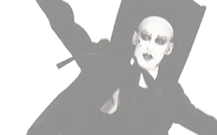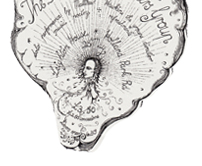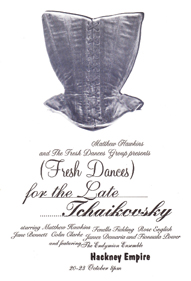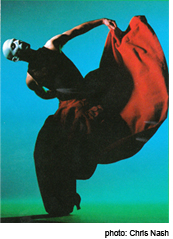| |

Matthew showed his first choreographies at informal events in studio theatres. These dances won no prizes but
they indicated a striking profile and acted as as credible components of a larger personal project.
Merce Cunningham and John Cage led the International Summer School for Choreographers and Composers in
1981 and Matthew was selected to attend as a nascent choreographer.
|
|
|
|
 |
The far-sighted American masters shared a
refreshingly practical approach which catalysed Hawkins skills through an inspired induction into the notion of task-setting
and methodical dance-making. Thus empowered, Matthew has subsequently proved his worth as a skilled and
thoughtful dance author.
|
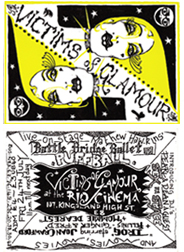 |
Hawkins' early full-length works were noted for their vigour and their visual audacity. Formal clarity and structural
concerns became embellished with an emerging personal 'signature'. A wide variety of venues, public spaces and
unusual environments played host to Hawkins' works and influenced their form. Matthew has also acknowledged
that his new dances can function as concert pieces in the public domain (in humourous, abstract or soul-baring
vein) but can also be mounted as a component of educational experience.
|
| As well as being artifacts in their own right (and sometimes very elaborate ones) Hawkins' works have comprised
explicit or more coded layers of observation and communication. Reviewers and dance writers have enjoyed
describing his multi-layered manifestation of ideas..... |
| |
|
|
|
 |
 |
|
| |
FRESH DANCES FOR THE LATE TCHAIKOVSKY
|
 |
Hackney Empire, London
......The Russian court resembled a faberge egg with a time bomb inside it. But the composer Peter ilyich Tchaikovsky had his private equivalent: recent research has suggested that he was blackmailed into taking his own life because of threats to ruin him by exposing his homosexuality. Not surprisingly, Matthew Hawkins' Fresh Dances For The Late Tchaikovsky emphasised not only the rapturous quality of his music but also its intensity..... Onstage, the ritualised elegance of the Russian court itself was seen, and its passion, dignity and wilful obliviousness to the outside world made it difficult to dispel the idea of imminent collapse. Fantasy offered one means of escape. So as the intricate mathemetics of the dancers' movement collapsed, hallucination took over and the evening ended with a parody of the toys from The Nurcracker: grotesque, portmanteau objects with people inside them, like a fashion display from a neighbouring planet......Kinky, lavish, perfectly imagined, each costume contained a proposition taken to its extreme. Only masque or pantomime could accommodate such lavish perfection.......
Stuart Morgan. FRIEZE magazine. Spring 1994 |
|
|
 |
 |
|
|
|
|
GREAT MOMENTS OF PURCELL AND BLOW
|
 |
Cottier theatre - Glasgow
.....Presence, absence. The themes twine through the whole evening. Hawkins himself speaks of them in occasional text that is as droll and cunningly fashioned as his choreography....This revival means that hawkins can introduce another element of his intricate thinking: ownership. As a creative artist he has the freedom - and most certainly the imagination - to take over the music, setting his own movements and ideas to it....After various exquisite dances to Purcell, Hawkins and his company of four fly out like some timeless sprites from a cosmic masque to dance with vibrancy and poignancy to John Blow's "Ode on the Death of Mr Henry Purcell". There are echoes of earlier sequences brought back into the flow of this work, as if echoing the idea that things past can be remembered. When the dance concludes, the moments of glorious precision, of idiosyncratic humour and sheer classic inventiveness are, technically at an end - but they will be summoned forth again....
Mary Brennan. The Herald. 4/11/1995 |
|
|
|
 |
 |
|
| |
ANGELS AND EXILES
|
|
Clore Studio - Royal Opera House - London
"Way above the top level of the Opera House auditorium is the new Clore Studio....it formed part of the theatre's redevelopment and exists to make new work possible......Matthew Hawkins began as a Royal Ballet dancer (and a notably good one) before moving to an independent career where
his collaborations have included Michael Clark, Rambert Dance and the Hackney Empire. Returning to his starting point, but finding everything as much changed as he himself, has provoked a makedly individual reinterpretation of classicism in "Angels and Exiles". Inspiration comes from the setting, the great high-ceilinged mirrored studio, surrounded by ballet barres and ample space for dancing; also the mixture of dancers, himself
and the admirable Yalckun Abdurehim and Kaori Suzuki from his own company and six Royal ballet dancers, some very young....Hawkins brings
out the personality of each dancer in patterns that cohere or effectively contrast. He uses a wide vocabulary of steps, subsumed into a sustained
style and spereading handsomely right across and around the space....After a recent series of ballets from other sources which have offered clever ideas (or sometimes not so clever) rather than real choreography, it is a pleasure to see a presentation that concentrates on beautiful and inventive dancing. Whatever else comes of the Clore Studio, "Angels and Exiles" already justifies all the effort and expenditure that has gone into it"
John Percival. The Times. 22/09/2000 |
|
|
 |
 |
|
|
| SILENT RHYTHMS |
|
Linbury Studio - Royal Opera House - London
...........Hawkins confirms a longevity with a canon of knowledge that is established, accessible and shared between several dance communities. The form of "Silent Rhythms" is a blend of classical and contemporary dance techniques that are fodder for a visionary like Hawkins whose own style has a particular bodily architechture and dynamic. Hawkins takes the gems of his dancers' embodied knowledge and weaves a work of crafted subtleties.....As Hawkins himself writes "you point'" to a space where dance is about graduations in dynamic, well timed demarcations in space, spatial relations and bodily designs that define their own inner significance. Similarly, Hawkins chisels his own benchmark in the canon of dancemaking and dance performance.
Thea Nerissa Barnes. criticaldance.com. 13/6/2003 |
|
|
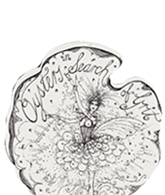 |
 |
| To see a short clip of Matthew Hawkins' choreography go to www.kinoki.co.uk - click on 'video' and then on Matthew Hawkins |
|
|
 |
|
